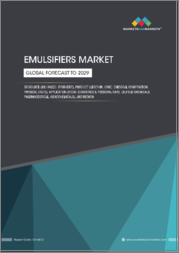
|
시장보고서
상품코드
1616696
레시틴 시장 기회, 성장 촉진요인, 산업 동향 분석, 예측(2024-2032년)Lecithin Market Opportunity, Growth Drivers, Industry Trend Analysis, and Forecast 2024 to 2032 |
||||||
레시틴 세계 시장은 2023년 23억 달러로 평가되며, 2024년부터 2032년까지 연평균 4.3%의 성장률을 보일 것으로 예상됩니다.
이 같은 성장은 클린 라벨 제품에 대한 선호도가 높아지면서 식음료 부문에서 천연 유화제로서 레시틴에 대한 수요가 증가하고 있기 때문으로 분석됩니다. Plant Based Foods Association(Plant Based Foods Association)의 보고서에 따르면, 식물성 식품 시장은 2020년까지 27% 성장할 것으로 예상되며, 식물성 원료로의 전환을 강조하는 식물성 식품 협회(Plant Based Foods Association)의 보고서에 따르면, 식물성 원료에 대한 소비자의 관심이 높아지면서 이 산업의 강력한 성장이 특징입니다. 식물성 원료로의 전환을 강조하고 있습니다. 더 건강한 식품 선택에 대한 관심은 천연 유화제 및 안정제로서 레시틴의 역할을 증폭시키고 있습니다.
레시틴은 식품, 음료, 의약품, 화장품 등 다양한 분야에 적용될 수 있기 때문에 수요가 더욱 증가하고 있습니다. 또한, 채식주의와 채식주의 트렌드의 증가는 특히 대두 기반 레시틴이 동물성 성분에 대한 적절한 대안을 제공함에 따라 시장을 강화하고 있습니다. 산업은 공급원, 용도, 지역별로 분류되며, 2023년에는 대두 레시틴 부문이 주목할 만한 시장 점유율을 차지했으며, 2032년에는 25억 달러가 넘을 것으로 예상됩니다. 대두 레시틴은 강력한 유화 특성으로 인해 음료 및 식품 부문에서 널리 사용되어 그 수요를 주도하고 있습니다.
식물성 및 유전자 변형이 없는 원료를 선호하는 소비자가 증가함에 따라 대두 레시틴, 특히 유기농 원료의 인기가 급상승하고 있습니다. 레시틴 시장의 음료 및 식품 부문은 2032년까지 연평균 6.1% 이상 성장할 것으로 예상되는 가운데, 가공식품 및 간편식에 대한 수요가 급증하면서 레시틴 시장의 음료 및 식품 부문이 성장세를 견인하고 있습니다. 수요가 급증하고 있습니다. 레시틴은 유화제, 안정제, 분산제로서 제빵 및 제과류에서 유제품 및 음료에 이르기까지 다양한 식품에서 중요한 역할을 하고 있습니다.
| 시장 범위 | |
|---|---|
| 시작 연도 | 2023년 |
| 예측 연도 | 2024-2032 |
| 시작 가격 | 23억 달러 |
| 예상 가격 | 36억 달러 |
| CAGR | 4.3% |
클린 라벨 운동은 소비자의 천연 성분에 대한 선호와 함께 레시틴에 대한 수요를 증폭시키고 있으며, 2023년에는 아시아태평양이 레시틴 시장에서 상당한 점유율을 차지할 것으로 예상되며 2032년까지 15억 달러를 돌파할 것으로 예상됩니다. 이 지역의 성장은 특히 가공식품 소비가 눈에 띄게 증가하고 있는 중국과 인도와 같은 국가에서 식음료 부문에서 레시틴에 대한 수요가 급증하고 있는 데 기인합니다. 또한 레시틴의 건강상의 이점과 제약 및 화장품과 같은 산업에서의 레시틴의 활용에 대한 인식이 높아짐에 따라 시장 확대가 가속화될 것으로 보입니다.
목차
제1장 조사 방법과 조사 범위
제2장 주요 요약
제3장 산업 인사이트
- 생태계 분석
- 밸류체인
- 주요 제조업체
- 시장 진출 루트
- 주요 유통업체
- 신규 유통 채널
- 산업 전체의 이익률
- 산업에 대한 영향요인
- 성장 촉진요인
- 시장 과제
- 시장 기회
- 신시장/용도
- 성장 가능성 분석
- 원료 상황
- 제조 동향
- 기술의 진화
- 가격 동향(지역별)(달러/톤)
- 북미
- 유럽
- 아시아태평양
- 라틴아메리카
- 중동·아시아
- 제조 동향
- 규제와 시장에 대한 영향
- Porters 분석
- PESTEL 분석
제4장 경쟁 구도
- 기업 점유율 분석
- 경쟁 포지셔닝 매트릭스
- 전략 전망 매트릭스
제5장 시장 규모와 예측 : 공급원별, 2021-2032년
- 주요 동향
- 대두 레시틴
- 유전자 재조합 대두 레시틴
- 비유전자 변형 대두 레시틴
- 카놀라 레시틴
- 해바라기 레시틴
- 난황 레시틴
제6장 시장 규모와 예측 : 용도별, 2021-2032년
- 주요 동향
- 식품 및 음료
- 동물 사료
- 의약품
- 화장품
- 산업
제7장 시장 규모와 예측 : 지역별, 2021-2032년
- 주요 동향
- 북미
- 미국
- 캐나다
- 유럽
- 독일
- 영국
- 프랑스
- 이탈리아
- 스페인
- 기타 유럽
- 아시아태평양
- 중국
- 인도
- 일본
- 한국
- 호주
- 기타 아시아태평양
- 라틴아메리카
- 브라질
- 멕시코
- 아르헨티나
- 기타 라틴아메리카
- 중동 및 아프리카
- 사우디아라비아
- 아랍에미리트
- 남아프리카공화국
- 기타 중동 및 아프리카
제8장 기업 개요
- Archer Daniels Midland(ADM)
- Cargill
- International Flavors & Fragrances(IFF)
- Bunge Limited
- GIIAVA
- Ruchi Soya
- Wilmar International
- Lipoid GmbH
- American Lecithin Company(ALC)
- Thew Arnott & Co. Ltd
- Sternchemie Gmbh & Co.KG
- Sodrugestvo
- DowDuPont
- LEKITHOS
- LECICO
- SOYA International
The Global Lecithin Market was valued at USD 2.3 billion in 2023 and is set to grow at a CAGR of 4.3% from 2024 to 2032. This expansion is fueled by the rising demand for lecithin as a natural emulsifier in the food and beverage sector, alongside the growing trend towards clean-label products. Robust growth characterizes the industry, spurred by heightened consumer interest in plant-based and clean-label ingredients. A report from the Plant Based Foods Association noted a 27% surge in the plant-based food market in 2020, underscoring the shift towards plant-based ingredients. This pivot towards healthier food choices has amplified lecithin's role as a natural emulsifier and stabilizer.
Lecithin's adaptability across diverse sectors spanning food, beverages, pharmaceuticals, and cosmetics further fuels its demand. Moreover, the escalating trends of veganism and vegetarianism bolster the market, especially since soy-based lecithin offers a suitable alternative to animal-derived components. The industry is classified into source, application, and region. In 2023, the soy lecithin segment captured a notable market share and is projected to exceed USD 2.5 billion by 2032. The prevalent use of soy lecithin in food and beverage sectors, attributed to its potent emulsifying traits, drives its demand.
With a growing consumer preference for plant-based and non-GMO ingredients, soy lecithin, especially from organic sources, is witnessing a surge in popularity. Its cost-effectiveness relative to alternative sources further solidifies its status as the go-to choice for manufacturers, propelling segment growth. Forecasted to grow at a CAGR of over 6.1% through 2032, the lecithin market's food and beverage segment is buoyed by surging demand for processed and convenience foods. Lecithin plays a pivotal role as an emulsifier, stabilizer, and dispersing agent across a spectrum of food items, from baked goods and confectioneries to dairy products and beverages.
| Market Scope | |
|---|---|
| Start Year | 2023 |
| Forecast Year | 2024-2032 |
| Start Value | $2.3 Billion |
| Forecast Value | $3.6 Billion |
| CAGR | 4.3% |
The clean-label movement, coupled with a consumer tilt towards natural ingredients, amplifies lecithin's demand in this arena. In 2023, the Asia Pacific held a substantial share of the lecithin market and is on track to surpass USD 1.5 billion by 2032. Growth in this region is largely attributed to the surging demand for lecithin in the food and beverage sector, especially in nations like China and India, where there is a notable uptick in processed food consumption. Furthermore, rising awareness about lecithin's health advantages and its applications in industries like pharmaceuticals and cosmetics will bolster the market expansion.
Table of Contents
Chapter 1 Methodology & Scope
- 1.1 Market scope & definition
- 1.2 Base estimates & calculations
- 1.3 Forecast calculation
- 1.4 Data sources
- 1.4.1 Primary
- 1.4.2 Data mining sources
- 1.4.2.1 Paid sources
- 1.4.2.2 Public sources
Chapter 2 Executive Summary
- 2.1 Industry 360° synopsis
Chapter 3 Industry Insights
- 3.1 Industry ecosystem analysis
- 3.1.1 Value chain
- 3.1.2 Key manufacturers
- 3.1.3 Go to market routes
- 3.1.4 Key distributors
- 3.1.4.1 New distribution channels
- 3.1.5 Profit margins across the industry
- 3.2 Industry impact forces
- 3.2.1 Growth drivers
- 3.2.2 Market challenges
- 3.2.3 Market opportunities
- 3.2.3.1 New markets/applications
- 3.2.3.2 Growth potential analysis
- 3.3 Raw material landscape
- 3.3.1 Manufacturing trends
- 3.3.1.1 Technology evolution
- 3.3.2 Pricing trend, by Region (USD/Ton)
- 3.3.2.1 North America
- 3.3.2.2 Europe
- 3.3.2.3 Asia Pacific
- 3.3.2.4 Latin America
- 3.3.2.5 Middle East & Asia
- 3.3.1 Manufacturing trends
- 3.4 Regulations & market impact
- 3.5 Porter's analysis
- 3.6 PESTEL analysis
Chapter 4 Competitive Landscape, 2023
- 4.1 Company market share analysis
- 4.2 Competitive positioning matrix
- 4.3 Strategic outlook matrix
Chapter 5 Market Size and Forecast, By Source, 2021-2032 (USD Million, Kilo Tons)
- 5.1 Key trends
- 5.2 Soy lecithin
- 5.2.1 GMO soy lecithin
- 5.2.2 Non-GMO soy lecithin
- 5.3 Canola lecithin
- 5.4 Sunflower lecithin
- 5.5 Egg yolk lecithin
Chapter 6 Market Size and Forecast, By Application, 2021-2032 (USD Million, Kilo Tons)
- 6.1 Key trends
- 6.2 Food & beverages
- 6.3 Animal feed
- 6.4 Pharmaceuticals
- 6.5 Cosmetics
- 6.6 Industrial
Chapter 7 Market Size and Forecast, By Region, 2021-2032 (USD Million, Kilo Tons)
- 7.1 Key trends
- 7.2 North America
- 7.2.1 U.S.
- 7.2.2 Canada
- 7.3 Europe
- 7.3.1 Germany
- 7.3.2 UK
- 7.3.3 France
- 7.3.4 Italy
- 7.3.5 Spain
- 7.3.6 Rest of Europe
- 7.4 Asia Pacific
- 7.4.1 China
- 7.4.2 India
- 7.4.3 Japan
- 7.4.4 South Korea
- 7.4.5 Australia
- 7.4.6 Rest of Asia Pacific
- 7.5 Latin America
- 7.5.1 Brazil
- 7.5.2 Mexico
- 7.5.3 Argentina
- 7.5.4 Rest of Latin America
- 7.6 MEA
- 7.6.1 Saudi Arabia
- 7.6.2 UAE
- 7.6.3 South Africa
- 7.6.4 Rest of MEA
Chapter 8 Company Profiles
- 8.1 Archer Daniels Midland (ADM)
- 8.2 Cargill
- 8.3 International Flavors & Fragrances (IFF)
- 8.4 Bunge Limited
- 8.5 GIIAVA,
- 8.6 Ruchi Soya
- 8.7 Wilmar International
- 8.8 Lipoid GmbH
- 8.9 American Lecithin Company (ALC)
- 8.10 Thew Arnott & Co. Ltd
- 8.11 Sternchemie Gmbh & Co.KG
- 8.12 Sodrugestvo
- 8.13 DowDuPont
- 8.14 LEKITHOS
- 8.15 LECICO
- 8.16 SOYA International



















